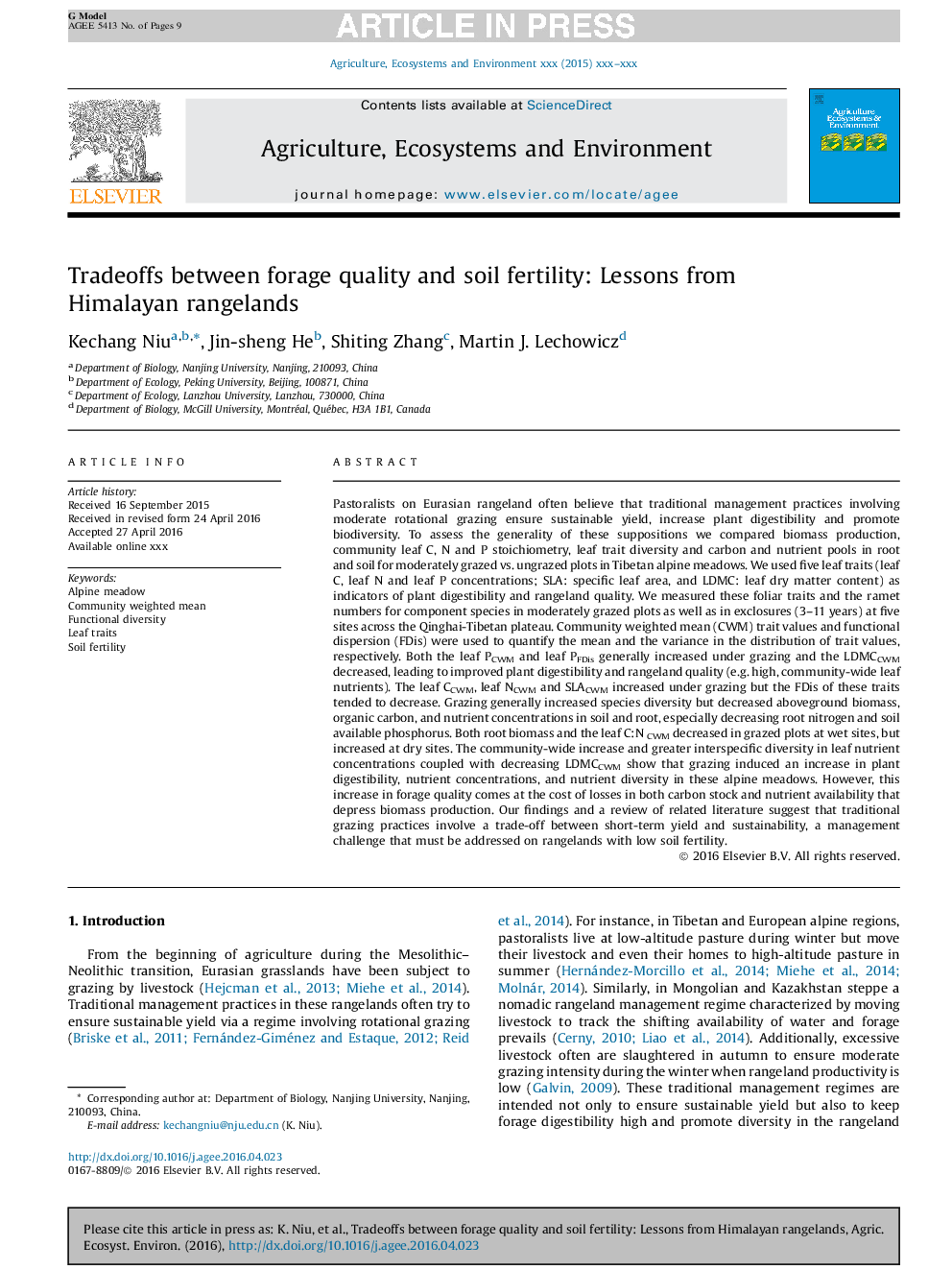| کد مقاله | کد نشریه | سال انتشار | مقاله انگلیسی | نسخه تمام متن |
|---|---|---|---|---|
| 5538120 | 1552018 | 2016 | 9 صفحه PDF | دانلود رایگان |
عنوان انگلیسی مقاله ISI
Tradeoffs between forage quality and soil fertility: Lessons from Himalayan rangelands
ترجمه فارسی عنوان
تجارت بین کیفیت علوفه و باروری خاک: درس های مراتع هیمالیا
دانلود مقاله + سفارش ترجمه
دانلود مقاله ISI انگلیسی
رایگان برای ایرانیان
کلمات کلیدی
چمنزار آلپ، جامعه معنی وزنی، تنوع عملیاتی، صفات برگ باروری خاک،
موضوعات مرتبط
علوم زیستی و بیوفناوری
علوم کشاورزی و بیولوژیک
علوم زراعت و اصلاح نباتات
چکیده انگلیسی
Pastoralists on Eurasian rangeland often believe that traditional management practices involving moderate rotational grazing ensure sustainable yield, increase plant digestibility and promote biodiversity. To assess the generality of these suppositions we compared biomass production, community leaf C, N and P stoichiometry, leaf trait diversity and carbon and nutrient pools in root and soil for moderately grazed vs. ungrazed plots in Tibetan alpine meadows. We used five leaf traits (leaf C, leaf N and leaf P concentrations; SLA: specific leaf area, and LDMC: leaf dry matter content) as indicators of plant digestibility and rangeland quality. We measured these foliar traits and the ramet numbers for component species in moderately grazed plots as well as in exclosures (3-11 years) at five sites across the Qinghai-Tibetan plateau. Community weighted mean (CWM) trait values and functional dispersion (FDis) were used to quantify the mean and the variance in the distribution of trait values, respectively. Both the leaf PCWM and leaf PFDis generally increased under grazing and the LDMCCWM decreased, leading to improved plant digestibility and rangeland quality (e.g. high, community-wide leaf nutrients). The leaf CCWM, leaf NCWM and SLACWM increased under grazing but the FDis of these traits tended to decrease. Grazing generally increased species diversity but decreased aboveground biomass, organic carbon, and nutrient concentrations in soil and root, especially decreasing root nitrogen and soil available phosphorus. Both root biomass and the leaf C:N CWM decreased in grazed plots at wet sites, but increased at dry sites. The community-wide increase and greater interspecific diversity in leaf nutrient concentrations coupled with decreasing LDMCCWM show that grazing induced an increase in plant digestibility, nutrient concentrations, and nutrient diversity in these alpine meadows. However, this increase in forage quality comes at the cost of losses in both carbon stock and nutrient availability that depress biomass production. Our findings and a review of related literature suggest that traditional grazing practices involve a trade-off between short-term yield and sustainability, a management challenge that must be addressed on rangelands with low soil fertility.
ناشر
Database: Elsevier - ScienceDirect (ساینس دایرکت)
Journal: Agriculture, Ecosystems & Environment - Volume 234, 16 October 2016, Pages 31-39
Journal: Agriculture, Ecosystems & Environment - Volume 234, 16 October 2016, Pages 31-39
نویسندگان
Kechang Niu, Jin-sheng He, Shiting Zhang, Martin J. Lechowicz,
